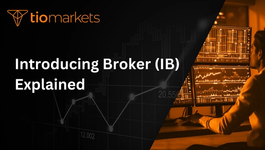S&P Midcap 400: Explained
BY TIOmarkets
|August 15, 2024The S&P MidCap 400 is a benchmark index that represents the mid-cap segment of the U.S. stock market. Developed by Standard & Poor's, it covers approximately 7% of the U.S. equity market, and is part of the wider S&P Composite 1500. This article will delve into the intricacies of the S&P MidCap 400, providing a comprehensive understanding of its role in trading.
Understanding the S&P MidCap 400 is crucial for traders and investors alike. It provides a snapshot of the mid-cap segment of the U.S. equity market, which is often overlooked in favor of large-cap indices like the S&P 500. This article will explore the S&P MidCap 400 in depth, providing insights into its composition, performance, and relevance to trading.
Understanding the S&P MidCap 400
The S&P MidCap 400 is a float-adjusted, market-capitalization-weighted index. This means that the weight of each constituent stock is determined by its market capitalization, adjusted for the number of shares available for trading. The index is designed to be representative of the mid-cap segment of the U.S. equity market, which includes companies with a market capitalization between $2 billion and $10 billion.
The index is rebalanced quarterly, ensuring that it remains representative of the mid-cap market. This rebalancing process involves adding and removing stocks based on their market capitalization, trading volume, and other factors. The S&P MidCap 400 is widely used as a benchmark for mid-cap investment products, and is also used as a performance benchmark by portfolio managers.
Composition of the S&P MidCap 400
The S&P MidCap 400 is composed of 400 mid-cap U.S. companies. These companies span all major sectors of the economy, providing a broad representation of the mid-cap market. The composition of the index is determined by the Index Committee at S&P Dow Jones Indices, which selects companies based on their market capitalization, liquidity, and industry representation.
The index is sector-diversified, meaning that it includes companies from all major sectors of the economy. This diversification helps to reduce the impact of sector-specific risks, and provides a more accurate representation of the overall mid-cap market. The sector weightings of the S&P MidCap 400 are regularly updated to reflect changes in the market.
Performance of the S&P MidCap 400
The performance of the S&P MidCap 400 is closely watched by traders and investors. It provides a barometer of the health of the mid-cap market, and can provide insights into broader market trends. The index is calculated in real-time, providing up-to-date information on the performance of the mid-cap market.
The performance of the S&P MidCap 400 is often compared to that of other indices, such as the S&P 500, which represents the large-cap market. This comparison can provide insights into the relative performance of different market segments, and can help traders and investors to make informed decisions.
The Role of the S&P MidCap 400 in Trading
The S&P MidCap 400 plays a crucial role in trading. It serves as a benchmark for mid-cap investment products, and is used by traders and investors to track the performance of the mid-cap market. The index also provides a basis for a range of investment products, including exchange-traded funds (ETFs), mutual funds, and derivatives.
Traders use the S&P MidCap 400 to gain exposure to the mid-cap market, and to hedge their positions. The index provides a cost-effective way to gain broad exposure to the mid-cap market, without having to buy individual stocks. It also provides a way for traders to hedge their positions, by taking positions that offset their exposure to the mid-cap market.
Trading S&P MidCap 400 ETFs
One of the most common ways to trade the S&P MidCap 400 is through ETFs. These are investment funds that track the performance of the index, and are traded on stock exchanges. ETFs provide a simple and cost-effective way to gain exposure to the mid-cap market, without having to buy individual stocks.
There are several ETFs that track the S&P MidCap 400, each with its own characteristics and fee structures. These ETFs provide a way for traders to gain exposure to the mid-cap market, and to hedge their positions. They also provide a way for investors to gain exposure to the mid-cap market, as part of a diversified portfolio.
Trading S&P MidCap 400 Derivatives
Another way to trade the S&P MidCap 400 is through derivatives. These are financial instruments whose value is derived from the performance of the index. Derivatives provide a way for traders to speculate on the direction of the mid-cap market, and to hedge their positions.
There are several types of derivatives that are based on the S&P MidCap 400, including futures and options. These derivatives provide a way for traders to gain exposure to the mid-cap market, and to hedge their positions. They also provide a way for investors to gain exposure to the mid-cap market, as part of a diversified portfolio.
Conclusion
The S&P MidCap 400 is a crucial tool for traders and investors. It provides a snapshot of the mid-cap segment of the U.S. equity market, and serves as a benchmark for mid-cap investment products. Understanding the S&P MidCap 400 can help traders and investors to make informed decisions, and to navigate the complexities of the financial markets.
Whether you're a trader looking to gain exposure to the mid-cap market, or an investor looking to diversify your portfolio, the S&P MidCap 400 provides a valuable resource. By understanding the intricacies of this index, you can enhance your trading strategy, and make more informed investment decisions.
Start Trading with TIOmarkets
Now that you're equipped with the knowledge of the S&P MidCap 400 and its significance in the financial markets, it's time to put that understanding into action. Join TIOmarkets, a top-rated forex broker, and start trading a diverse range of over 300 instruments across 5 markets, including indices like the S&P MidCap 400. Benefit from low fees and our extensive suite of educational resources to sharpen your trading skills. With over 170,000 accounts opened in more than 170 countries, we're ready to help you embark on your trading journey. Create a Trading Account today and take the first step towards trading with confidence and expertise.

Risk disclaimer: CFDs are complex instruments and come with a high risk of losing money rapidly due to leverage. You should consider whether you understand how CFDs work and whether you can afford to take the high risk of losing your money. Never deposit more than you are prepared to lose. Professional client’s losses can exceed their deposit. Please see our risk warning policy and seek independent professional advice if you do not fully understand. This information is not directed or intended for distribution to or use by residents of certain countries/jurisdictions including, but not limited to, USA & OFAC. The Company holds the right to alter the aforementioned list of countries at its own discretion.
Join us on social media

Behind every blog post lies the combined experience of the people working at TIOmarkets. We are a team of dedicated industry professionals and financial markets enthusiasts committed to providing you with trading education and financial markets commentary. Our goal is to help empower you with the knowledge you need to trade in the markets effectively.





